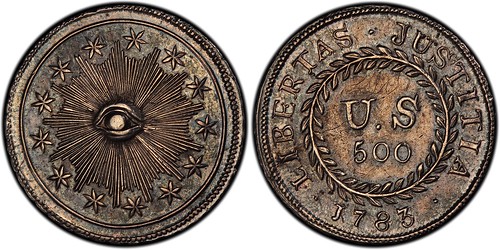
PREV ARTICLE
NEXT ARTICLE
FULL ISSUE
PREV FULL ISSUE
NOVA CONSTELLATIO QUINT STRUCK AS AMERICAN COINHere's a lengthy excerpt from a press release published August 1, 2017 regarding new research on an important early U.S. coin. It's a great example of where numismatic
research can lead - sometimes information hiding in plain sight has managed to elude researchers for years. -Editor
 David McCarthy, senior numismatist at Kagin’s, Inc. of Tiburon, California (www.Kagins.com), has pinpointed the 1783 plain obverse Nova Constellatio Quint pattern (Breen-1102, W-1830) as the first coin officially struck by authority of the United States government, a finding hailed by another U.S. rare coin expert as “one of the most exciting developments in modern numismatics.” Results of McCarthy’s research on the unique, early American experimental silver coin, that once was in the hands of one of the USA’s Founding Fathers, Alexander Hamilton, are in the August 2017 edition of “The Numismatist,” the official journal of the American Numismatic Association (www.money.org). “Although the coin was discovered in 1870, it was misattributed. We now have compelling evidence that it is, ‘the first that has been struck as an American coin,’ as described in the April 2, 1783 diary entry of Robert Morris, a signer of the Declaration of Independence and the U.S. government’s first Superintendent of Finance,” explained McCarthy. “The Quint and a subsequent set of coins were created in Philadelphia in April of 1783 under authority of the Treasury some nine years before the next coins would be struck by the U.S. government. It would have been valued at 500-units in a proposed system that would range from 5 to 1,000 units,” McCarthy said. “This was the first use of the vital and enduring decimal system to be established in the western world,” stated Kagin. During the 1770s and 1780s several states and private individuals manufactured coins, but this is the first coin that was struck and paid for by the U.S. government, according to McCarthy’s research, which a dozen other early American coin experts agreed with before he submitted it for publication. After examining McCarthy’s research, early American coins researcher and writer John Dannreuther of Memphis, Tennessee, the American Numismatic Association’s 2007 Numismatist of the Year, summed up the findings: “There is a first United States coin, as we have written evidence (in the April 2, 1783 diary entry of Robert Morris, U.S. Superintendent of Finance) that one was delivered: ‘I sent for (metallurgist) Mr. (Benjamin) Dudley who delivered me a Piece of Silver Coin being the first that has been struck as an American Coin.’ “The only coin that logically could be this coin is the Plain Obverse Quint. “There are numerous things that bring us to this conclusion, the first being that “Nova Constellatio” is not found on the Plain Legend Quint. One does not remove legends, they are added,” explained Dannreuther. “Secondly, the number of dies noted in the literature can be made to match only by having one die ground down and reengraved. After overlaying the two Quint types, it became obvious that the Plain Obverse die’s eye matched the with Legend eye. Since this is the highest point of the coin, it is the lowest part of the die, as well as the center, it would be logical to leave a small amount of this area as a starting point for the new die. The rest of the die’s detail was removed by the grinding process, of course.” “Thirdly, the two Quint dies obviously were engraved by two different hands. Since, we know that the with Legend coins match the other denominations in style, as well as having the “Nova Constellatio” legend, the Plain Obverse has to be the first one – thus, it is the first United States coin,” stated Dannreuther. Only two examples of the 500-unit coin are known, and each is distinctively different on the front. One has the words, NOVA CONSTELLATIO, Latin for “a new constellation,” while the other example does not have any words. The research demonstrates the coin without the words on the obverse was struck first. After surfacing in New York City nearly 150 years ago, the coin was carefully preserved in several major collections including Lorin G. Parmelee, S.H. and H. Chapman and Wayte Raymond before becoming part of the Garrett Collection and into the possession of Johns Hopkins University where it resided for much of the 20th century. Only now, though, has numismatic research brought together evidence that it was the first federal coin made by authority of the U.S. government. The coin was available for viewing at the Kagin's table at this week's ANA convention in Denver. See my Numismatic Diary elsewhere in this issue for a picture. -Editor
 Wayne Homren, Editor The Numismatic Bibliomania Society is a non-profit organization promoting numismatic literature. See our web site at coinbooks.org. To submit items for publication in The E-Sylum, write to the Editor at this address: whomren@gmail.com To subscribe go to: https://my.binhost.com/lists/listinfo/esylum All Rights Reserved. NBS Home Page Contact the NBS webmaster 
|